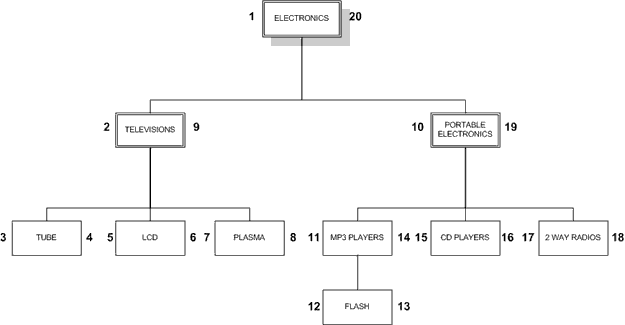Using SQL Server, following script seems to be working for me.
Output testscript
category_id name parent lft rgt lftcalc rgtcalc
----------- -------------------- ----------- ----------- ----------- ----------- -----------
1 ELECTRONICS NULL 1 20 1 20
2 TELEVISIONS 1 2 9 2 9
3 TUBE 2 3 4 3 4
4 LCD 2 5 6 5 6
5 PLASMA 2 7 8 7 8
6 PORTABLE ELECTRONICS 1 10 19 10 19
7 MP3 PLAYERS 6 11 14 11 14
8 FLASH 7 12 13 12 13
9 CD PLAYERS 6 15 16 15 16
10 2 WAY RADIOS 6 17 18 17 18
Script
SET NOCOUNT ON
GO
DECLARE @nested_category TABLE (
category_id INT PRIMARY KEY,
name VARCHAR(20) NOT NULL,
parent INT,
lft INT,
rgt INT
);
DECLARE @current_Category_ID INTEGER
DECLARE @current_parent INTEGER
DECLARE @SafeGuard INTEGER
DECLARE @myLeft INTEGER
SET @SafeGuard = 100
INSERT INTO @nested_category
SELECT 1,'ELECTRONICS',NULL,NULL,NULL
UNION ALL SELECT 2,'TELEVISIONS',1,NULL,NULL
UNION ALL SELECT 3,'TUBE',2,NULL,NULL
UNION ALL SELECT 4,'LCD',2,NULL,NULL
UNION ALL SELECT 5,'PLASMA',2,NULL,NULL
UNION ALL SELECT 6,'PORTABLE ELECTRONICS',1,NULL,NULL
UNION ALL SELECT 7,'MP3 PLAYERS',6,NULL,NULL
UNION ALL SELECT 8,'FLASH',7,NULL,NULL
UNION ALL SELECT 9,'CD PLAYERS',6,NULL,NULL
UNION ALL SELECT 10,'2 WAY RADIOS',6,NULL,NULL
/* Initialize */
UPDATE @nested_category
SET lft = 1
, rgt = 2
WHERE parent IS NULL
UPDATE @nested_category
SET lft = NULL
, rgt = NULL
WHERE parent IS NOT NULL
WHILE EXISTS (SELECT * FROM @nested_category WHERE lft IS NULL) AND @SafeGuard > 0
BEGIN
SELECT @current_Category_ID = MAX(nc.category_id)
FROM @nested_category nc
INNER JOIN @nested_category nc2 ON nc2.category_id = nc.parent
WHERE nc.lft IS NULL
AND nc2.lft IS NOT NULL
SELECT @current_parent = parent
FROM @nested_category
WHERE category_id = @current_category_id
SELECT @myLeft = lft
FROM @nested_category
WHERE category_id = @current_parent
UPDATE @nested_category SET rgt = rgt + 2 WHERE rgt > @myLeft;
UPDATE @nested_category SET lft = lft + 2 WHERE lft > @myLeft;
UPDATE @nested_category SET lft = @myLeft + 1, rgt = @myLeft + 2 WHERE category_id = @current_category_id
SET @SafeGuard = @SafeGuard - 1
END
SELECT * FROM @nested_category ORDER BY category_id
SELECT COUNT(node.name), node.name, MIN(node.lft)
FROM @nested_category AS node,
@nested_category AS parent
WHERE node.lft BETWEEN parent.lft AND parent.rgt
GROUP BY
node.name
ORDER BY
3, 1
Testscript ##
SET NOCOUNT ON
GO
DECLARE @nested_category TABLE (
category_id INT PRIMARY KEY,
name VARCHAR(20) NOT NULL,
parent INT,
lft INT,
rgt INT,
lftcalc INT,
rgtcalc INT
);
INSERT INTO @nested_category
SELECT 1,'ELECTRONICS',NULL,1,20,NULL,NULL
UNION ALL SELECT 2,'TELEVISIONS',1,2,9,NULL,NULL
UNION ALL SELECT 3,'TUBE',2,3,4,NULL,NULL
UNION ALL SELECT 4,'LCD',2,5,6,NULL,NULL
UNION ALL SELECT 5,'PLASMA',2,7,8,NULL,NULL
UNION ALL SELECT 6,'PORTABLE ELECTRONICS',1,10,19,NULL,NULL
UNION ALL SELECT 7,'MP3 PLAYERS',6,11,14,NULL,NULL
UNION ALL SELECT 8,'FLASH',7,12,13,NULL,NULL
UNION ALL SELECT 9,'CD PLAYERS',6,15,16,NULL,NULL
UNION ALL SELECT 10,'2 WAY RADIOS',6,17,18,NULL,NULL
/* Initialize */
UPDATE @nested_category
SET lftcalc = 1
, rgtcalc = 2
WHERE parent IS NULL
DECLARE @current_Category_ID INTEGER
DECLARE @current_parent INTEGER
DECLARE @SafeGuard INTEGER
DECLARE @myRight INTEGER
DECLARE @myLeft INTEGER
SET @SafeGuard = 100
WHILE EXISTS (SELECT * FROM @nested_category WHERE lftcalc IS NULL) AND @SafeGuard > 0
BEGIN
SELECT @current_Category_ID = MAX(nc.category_id)
FROM @nested_category nc
INNER JOIN @nested_category nc2 ON nc2.category_id = nc.parent
WHERE nc.lftcalc IS NULL
AND nc2.lftcalc IS NOT NULL
SELECT @current_parent = parent
FROM @nested_category
WHERE category_id = @current_category_id
SELECT @myLeft = lftcalc
FROM @nested_category
WHERE category_id = @current_parent
UPDATE @nested_category SET rgtcalc = rgtcalc + 2 WHERE rgtcalc > @myLeft;
UPDATE @nested_category SET lftcalc = lftcalc + 2 WHERE lftcalc > @myLeft;
UPDATE @nested_category SET lftcalc = @myLeft + 1, rgtcalc = @myLeft + 2 WHERE category_id = @current_category_id
SELECT * FROM @nested_category WHERE category_id = @current_parent
SELECT * FROM @nested_category ORDER BY category_id
SET @SafeGuard = @SafeGuard - 1
END
SELECT * FROM @nested_category ORDER BY category_id
SELECT COUNT(node.name), node.name, MIN(node.lft)
FROM @nested_category AS node,
@nested_category AS parent
WHERE node.lft BETWEEN parent.lft AND parent.rgt
GROUP BY
node.name
ORDER BY
3, 1

